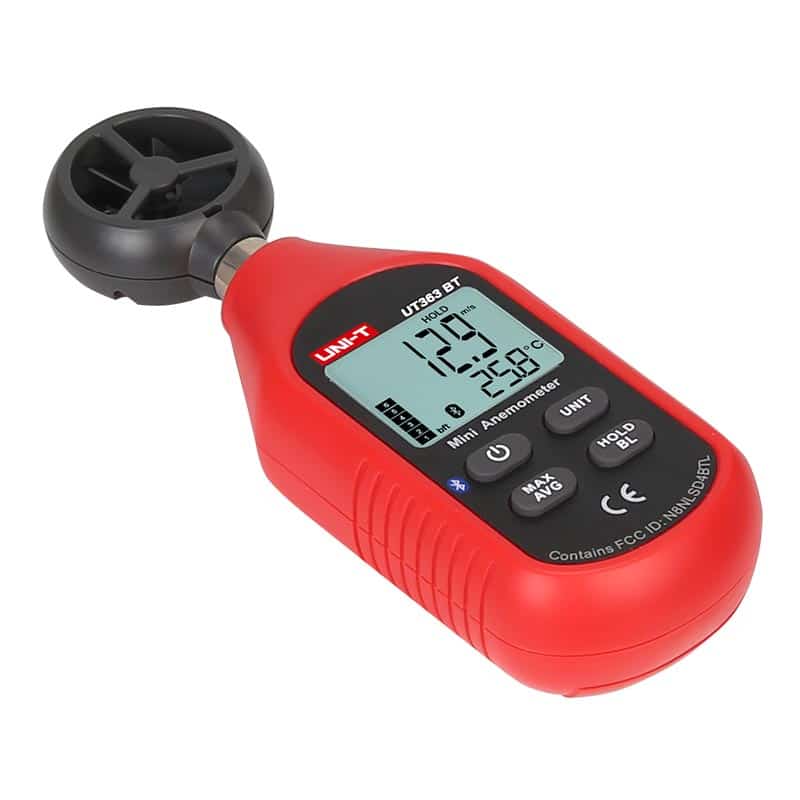Expert Tips for Calibrating Your Anemometer for Optimal Efficiency
Expert Tips for Calibrating Your Anemometer for Optimal Efficiency
Blog Article
All You Required to Know Concerning Anemometers: How They Function, Why They Matter, and Where to Make use of Them
Anemometers, though often forgotten in the world of clinical tools, play a crucial duty in various areas, using useful understandings into wind rate and air movement patterns. As we dig right into the details of anemometer technology, we will discover the inner functions of these gadgets, their value, and the vital considerations when choosing the appropriate anemometer for specific applications.

Anemometer Basics
An important instrument used to measure wind rate and direction, the anemometer plays an important role in meteorology and numerous industries. An anemometer normally includes three or 4 cups that rotate in the wind, a vane that aims right into the wind, and sensors to track the movements or turnings. By determining the rotations or motions over a specific amount of time, the anemometer can identify wind speed. The vane helps establish wind direction by directing right into the wind, supplying important information for climate forecasting, aviation, maritime procedures, ecological tracking, and wind energy applications.
There are numerous kinds of anemometers readily available, consisting of mug anemometers, vane anemometers, hot-wire anemometers, and sonic anemometers, each with its distinct attributes and applications. Cup anemometers are typically used for fundamental wind rate measurements, while vane anemometers are chosen for directional dimensions. Hot-wire anemometers are appropriate for reduced airspeeds, and sonic anemometers are perfect for high-precision measurements in research and industrial settings. Recognizing the essentials of anemometers is vital for exact wind data collection and analysis across different fields.
Principles of Anemometer Operation
Structure on the foundational understanding of anemometer basics, the principles of anemometer operation elucidate the auto mechanics behind wind speed and direction measurements. Anemometers operate the principle of air flow influencing a sensing unit, creating it to rotate. Cup anemometers, for example, have three or even more cups that catch the wind, causing them to rotate faster as the wind speed boosts. The rotation speed is then converted into a wind speed measurement. Vane anemometers, on the various other hand, use a tail or a probe that aligns itself with the wind direction, giving a measurement of wind direction based upon the alignment of the sensing unit. Hot-wire anemometers rely upon a warmed cable that cools off as wind passes over it, with the rate of cooling figuring out the wind speed. Ultrasonic anemometers step wind rate and direction by evaluating the time it takes for ultrasonic signals to take a trip in between transducers. Recognizing these concepts is critical for reliable and precise wind dimensions in numerous applications.
Relevance of Anemometers
Anemometers play a critical function in determining wind rate and direction, supplying crucial information for climate projecting, environment studies, environmental monitoring, and aviation operations. Meteorologists rely on anemometers to gather accurate wind information, assisting them comprehend climate patterns, anticipate tornados, and issue timely warnings to the public. Wind farm drivers use anemometers to assess wind conditions and make the most of electrical power manufacturing from wind generators.
Applications Across Different Industries
Applications of anemometers extend across diverse industries, showcasing their versatility and utility past meteorology. In the eco-friendly energy sector, anemometers play an essential role in examining wind problems for wind farm placements, making sure ideal power production. Industries like construction and mining use anemometers to keep track of wind rates, critical for safety and security protocols, especially when operating at heights or in open-pit mines where strong winds can posture dangers. Anemometers are also integral in the aviation market, aiding pilots in comprehending airspeed and wind instructions for risk-free take-offs and landings. The maritime market take advantage of anemometers for ship navigating, helping sailors expect weather modifications and readjust paths accordingly. In agriculture, anemometers assist farmers in handling crop spraying by giving real-time data on wind rate to stay clear of drift. Anemometers discover applications in HVAC systems to maximize air flow and enhance power efficiency in buildings. The varied use instances of anemometers emphasize their relevance across numerous markets, highlighting their important duty in enhancing functional security and efficiency (anemometer).

Picking the Right Anemometer for Your Demands
For general objectives, a cup anemometer is ideal for gauging wind rate, while a vane anemometer offers wind instructions data. Hot-wire anemometers are perfect for low airspeed dimensions, and ultrasonic anemometers supply high precision and sturdiness.

Verdict
To conclude, anemometers play a critical duty in gauging wind rate and direction across different industries. Understanding the concepts of anemometer operation is vital for selecting the appropriate tool for certain demands. From weather forecasting to aviation, anemometers are important tools for guaranteeing and collecting precise information safety in various applications. When choosing the most appropriate device for try this out gauging wind conditions., it is important to consider the significance of anemometers in order to make enlightened decisions.
There are various types of anemometers readily available, including cup anemometers, vane anemometers, hot-wire anemometers, and sonic anemometers, each with its unique attributes and applications. Mug anemometers are typically made use of for basic wind speed measurements, while vane anemometers are favored for directional dimensions. Hot-wire anemometers are ideal for low airspeeds, and sonic anemometers are ideal for high-precision measurements in research and industrial setups.Building on the fundamental understanding of anemometer basics, the concepts of anemometer procedure clarify the technicians behind wind moved here speed and instructions dimensions. For general purposes, a cup anemometer is suitable for measuring wind speed, while a vane anemometer gives wind direction information.
Report this page